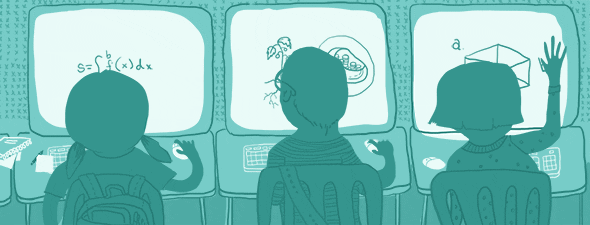No More Pencils, No More Books
Artificially intelligent software is replacing the textbook—and reshaping American education.

Illustration by Natalie Matthews-Ramo
By Will Oremus
ighteen students file into a brightly lit classroom. Arrayed around its perimeter are 18 computers. The students take their seats, log in to their machines, and silently begin working. At a desk in the back, the instructor’s screen displays a series of spreadsheets and data visualizations to help her track each student’s progress in real time.
This isn’t a Vulcan finishing school or a scene from some Back to the Futuresequel. It’s Sheela Whelan’s pre-algebra class at Westchester Community College in Valhalla, New York.
The students in Whelan’s class are all using the same program, called ALEKS. But peek over their shoulders and you’ll see that each student is working on a different sort of problem. A young woman near the corner of the room is plugging her way through a basic linear equation. The young man to her left is trying to wrap his mind around a story problem involving fractions. Nearby, a more advanced student is simplifying equations that involve both variables and fractions.
At first glance, each student appears to be at a different point in the course. And that’s true, in one sense. But it’s more accurate to say that the course is literally different for each student.
Just a third of the way through the semester, a few of the most advanced students are nearly ready for the final exam. Others lag far behind. They’re all responsible for mastering the same concepts and skills. But the order in which they tackle them, and the pace at which they do so, is up to the artificially intelligent software that’s guiding them through the material and assessing their performance at every turn.
ALEKS starts everyone at the same point. But from the moment students begin to answer the practice questions that it automatically generates for them, ALEKS’ machine-learning algorithms are analyzing their responses to figure out which concepts they understand and which they don’t. A few wrong answers to a given type of question, and the program may prompt them to read some background materials, watch a short video lecture, or view some hints on what they might be doing wrong. But if they’re breezing through a set of questions on, say, linear inequalities, it may whisk them on to polynomials and factoring. Master that, and ALEKS will ask if they’re ready to take a test. Pass, and they’re on to exponents—unless they’d prefer to take a detour into a different topic, like data analysis and probability. So long as they’ve mastered the prerequisites, which topic comes next is up to them.Whelan, the instructor, does not lecture. What would be the point, when no two students are studying the same thing? Instead, she serves as a sort of roving tutor, moving from one student to the next as they call on her for help. A teaching assistant is also on call to help those who get stuck or to verify that they’re ready to take their next test. As the students work, the software logs everything from which questions they get right and wrong to the amount of time they spend on each one. When Whelan’s online dashboard tells her that several are struggling with the same concept, she’ll assemble those students and work through some problems as a small group. It’s teaching as triage.
The result is a classroom experience starkly different from the model that hasAdaptive learning software is replacing textbooks and upending American education. Should we welcome it?:
